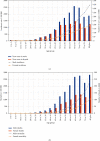Cancer Burden in China during 1990-2019: Analysis of the Global Burden of Disease
- PMID: 35463971
- PMCID: PMC9023157
- DOI: 10.1155/2022/3918045
Cancer Burden in China during 1990-2019: Analysis of the Global Burden of Disease
Abstract
This study reports the risk factors, trends, and burden of cancer in China from 1990 to 2019 from the Global Burden of Diseases. The incidence, mortality, and DALY of all cancers in China for the past 30 years were analyzed. In 2019, the age-standardized rates (ASRs) of cancer incidence, mortality, and DALY in China were 232.42/100 000, 136.72/100 000, and 3288.22/100 000, respectively. The five cancers with the highest age-standardized incidence rates were lung, stomach, colorectal, breast, and prostate cancers. From 1990 to 2019, the number of new cancer cases, deaths, and DALY increased by 168.78%, 86.89%, and 51.20%, respectively. The ASR increased by 22.21% for incidence and decreased by 19.01% and 27.19% for mortality and DALY, respectively, and their corresponding average annual percent change values were 0.71, -0.80, and -1.26, respectively. The main risk factors for cancer in China were smoking, air pollution, dietary factors, and alcohol use. From 1990 to 2019, the cancer incidence rate was on the rise, and cancer mortality and DALY rates were declining; however, these characteristics vary by cancer site. Therefore, current prevention strategies should be reoriented, and specific strategies for cancers in different sites should be established to prevent the increase in cancer cases.
Copyright © 2022 Shu-Zhen Zhang et al.
Conflict of interest statement
The authors declare no conflict of interest.
Figures
Similar articles
-
Cancer burden and risk in the Chinese population aged 55 years and above: A systematic analysis and comparison with the USA and Western Europe.J Glob Health. 2024 Jan 26;14:04014. doi: 10.7189/jogh.14.04014. J Glob Health. 2024. PMID: 38271210 Free PMC article.
-
[Disease burden of prostate cancer among men in China, from 1990 to 2013].Zhonghua Liu Xing Bing Xue Za Zhi. 2016 Jun;37(6):778-82. doi: 10.3760/cma.j.issn.0254-6450.2016.06.007. Zhonghua Liu Xing Bing Xue Za Zhi. 2016. PMID: 27346101 Chinese.
-
[Disease burden of breast cancer in women in China, 1990-2017].Zhonghua Liu Xing Bing Xue Za Zhi. 2021 Jul 10;42(7):1225-1230. doi: 10.3760/cma.j.cn112338-20200908-01139. Zhonghua Liu Xing Bing Xue Za Zhi. 2021. PMID: 34814535 Chinese.
-
Global, regional, and national burden of respiratory tract cancers and associated risk factors from 1990 to 2019: a systematic analysis for the Global Burden of Disease Study 2019.Lancet Respir Med. 2021 Sep;9(9):1030-1049. doi: 10.1016/S2213-2600(21)00164-8. Epub 2021 Aug 16. Lancet Respir Med. 2021. PMID: 34411511 Free PMC article.
-
The global burden of ischemic stroke: findings of the GBD 2010 study.Glob Heart. 2014 Mar;9(1):107-12. doi: 10.1016/j.gheart.2014.01.001. Glob Heart. 2014. PMID: 25432120 Review.
Cited by
-
The burden of colorectal cancer attributable to high body mass index in China: findings from 1990 to 2021 and prediction to 2035.Int J Colorectal Dis. 2025 May 5;40(1):108. doi: 10.1007/s00384-025-04877-y. Int J Colorectal Dis. 2025. PMID: 40323366 Free PMC article.
-
Developing Mouse Models for Ovarian Tissue Transplantation and Xenotransplantation: A Review.Med Sci Monit. 2025 Mar 13;31:e946386. doi: 10.12659/MSM.946386. Med Sci Monit. 2025. PMID: 40077859 Free PMC article. Review.
-
Sex difference in alcohol consumption associated with colorectal cancer risk in Quzhou, China: A nested case-control study.Prev Med Rep. 2024 Jun 28;44:102807. doi: 10.1016/j.pmedr.2024.102807. eCollection 2024 Aug. Prev Med Rep. 2024. PMID: 39055640 Free PMC article.
-
Targeting TMEM88 as an Attractive Therapeutic Strategy in Malignant Tumors.Front Oncol. 2022 Jun 6;12:906372. doi: 10.3389/fonc.2022.906372. eCollection 2022. Front Oncol. 2022. PMID: 35734592 Free PMC article. Review.
-
Evaluating the impact of PD-1 inhibitor treatment on key health outcomes for cancer patients in China.Int J Clin Pharm. 2024 Apr;46(2):429-438. doi: 10.1007/s11096-023-01675-w. Epub 2024 Jan 2. Int J Clin Pharm. 2024. PMID: 38165516
References
MeSH terms
LinkOut - more resources
Full Text Sources
Medical
Miscellaneous



